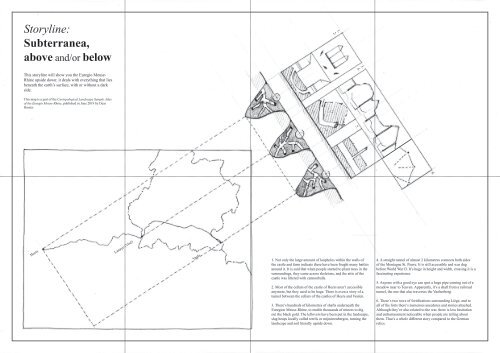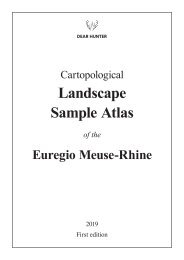Cartopological Landscape Sample Atlas of the Euregio Meuse-Rhine (MAPS)
First edition by Dear Hunter, June 2019
First edition by Dear Hunter, June 2019
You also want an ePaper? Increase the reach of your titles
YUMPU automatically turns print PDFs into web optimized ePapers that Google loves.
Storyline:<br />
Subterranea,<br />
above and/or below<br />
1.<br />
2.<br />
3.<br />
4.<br />
This storyline will show you <strong>the</strong> <strong>Euregio</strong> <strong>Meuse</strong>-<br />
<strong>Rhine</strong> upside down: it deals with everything that lies<br />
beneath <strong>the</strong> earth’s surface, with or without a dark<br />
side.<br />
This map is a part <strong>of</strong> <strong>the</strong> <strong>Cartopological</strong> <strong>Landscape</strong> <strong>Sample</strong> <strong>Atlas</strong><br />
<strong>of</strong> <strong>the</strong> <strong>Euregio</strong> <strong>Meuse</strong>-<strong>Rhine</strong>, published in June 2019 by Dear<br />
Hunter.<br />
5.<br />
6.<br />
Heers<br />
Lanaye (Visé)<br />
Vaals<br />
1. Not only <strong>the</strong> large amount <strong>of</strong> loopholes within <strong>the</strong> walls <strong>of</strong><br />
<strong>the</strong> castle and farm indicate <strong>the</strong>re have been fought many battles<br />
around it. It is said that when people started to plant trees in <strong>the</strong><br />
surroundings, <strong>the</strong>y came across skeletons, and <strong>the</strong> attic <strong>of</strong> <strong>the</strong><br />
castle was littered with cannonballs.<br />
2. Most <strong>of</strong> <strong>the</strong> cellars <strong>of</strong> <strong>the</strong> castle <strong>of</strong> Heers aren’t accessible<br />
anymore, but <strong>the</strong>y used to be huge. There is even a story <strong>of</strong> a<br />
tunnel between <strong>the</strong> cellars <strong>of</strong> <strong>the</strong> castles <strong>of</strong> Heers and Veulen.<br />
3. There’s hundreds <strong>of</strong> kilometres <strong>of</strong> shafts underneath <strong>the</strong><br />
<strong>Euregio</strong>n <strong>Meuse</strong>-<strong>Rhine</strong>, to enable thousands <strong>of</strong> miners to dig<br />
out <strong>the</strong> black gold. The leftovers have been put in <strong>the</strong> landscape,<br />
slag heaps locally called terrils or mijnsteenbergen, turning <strong>the</strong><br />
landscape and soil literally upside down.<br />
4. A straight tunnel <strong>of</strong> almost 2 kilometres connects both sides<br />
<strong>of</strong> <strong>the</strong> Montagne St. Pierre. It is still accessible and was dug<br />
before World War II. It’s huge in height and width, crossing it is a<br />
fascinating experience.<br />
5. Anyone with a good eye can spot a huge pipe coming out <strong>of</strong> a<br />
meadow near to Teuven. Apparently, it’s a shaft from a railroad<br />
tunnel, <strong>the</strong> one that also traverses <strong>the</strong> Vaalserberg.<br />
6. There’s two rows <strong>of</strong> fortifications surrounding Liège, and to<br />
all <strong>of</strong> <strong>the</strong> forts <strong>the</strong>re’s numerous anecdotes and stories attached.<br />
Although <strong>the</strong>y’re also related to <strong>the</strong> war, <strong>the</strong>re is less hesitation<br />
and embarrassment noticeable when people are telling about<br />
<strong>the</strong>m. That’s a whole different story compared to <strong>the</strong> German<br />
relics.

















